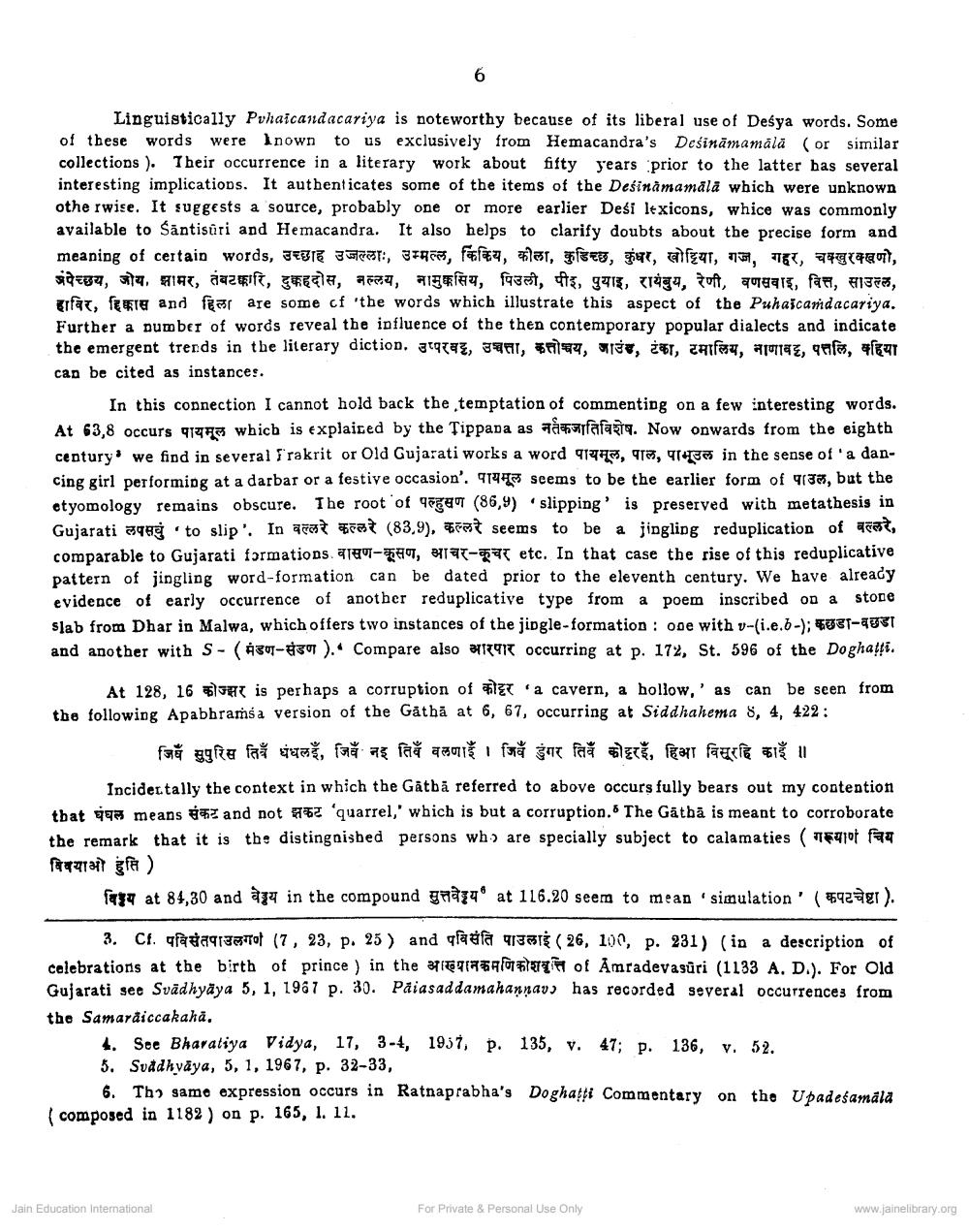Book Title: Puhaichandchariyam Author(s): Shantisuri, Ramnikvijay Gani Publisher: Prakrit Text Society Ahmedabad View full book textPage 9
________________ Linguistically Puhaicand acariya is noteworthy because of its liberal use of Desya words. Some of these words were Inown to us exclusively from Hemacandra's Desināmamála (or similar collections ). Their occurrence in a literary work about fifty years prior to the latter has several interesting implications. It authenticates some of the items of the Dešinamamala which were unknown otherwise. It suggests a source, probably one or more earlier Desi lexicons, whice was commonly available to Säntisuri and Hemacandra. It also helps to clarify doubts about the precise form and meaning of certain words, Jegik 34 :, 375 , f q, at, ftes, 47, afeg, 70, 767, 74774@il, 5994, 14. mar, azeift, GRECIA, 1774, 194, 1951, 45, gais, trigy, Tuft, w ars, faer, F13a, cfar, fekte and fear are some of the words which illustrate this aspect of the Puhaicamdacariya. Further a number of words reveal the influence of the then contemporary popular dialects and indicate the emergent trends in the literary diction. 31978z, 5261, 4, aiše, żRT, zatfeu, amaz, qaifa, #fear can be cited as instances. In this connection I cannot hold back the temptation of commenting on a few interesting words. At 63,8 occurs 91973 which is explaiced by the Tippapa as à affala519. Now onwards from the eighth century. we find in several Trakrit or Old Gujarati works a word 91942, 93, 9145 in the sense of 'a dancing girl performing at a darbar or a festive occasion'. 914 seems to be the earlier form of 45, but the etyomology remains obscure. The root of 4 (86,9) slipping' is preserved with metathesis in Gujarati लपसबुं - to slip'. In वल्लरे कल्लरे (83.9), कल्लरे seems to be ajingling reduplication of बल्लरे, comparable to Gujarati formations. वासण-कूसण, आचर-कूचर etc. In that case the rise of this reduplicative pattern of jingling word-formation can be dated prior to the eleventh century. We have already evidence of early occurrence of another reduplicative type from a poem inscribed on a stone Slab from Dhar in Malwa, which offers two instances of the jingle-formation : ope with v-(i..-); 381-1981 and another with S- 4301-59). Compare also 317917 occurring at p. 172, St. 596 of the Doghati. At 128, 16 h is perhaps a corruption of ter a cavern, a hollow,' as can be seen from the following Apabhramsa version of the Gatha at 6, 67, occurring at Siddhahema S, 4, 422: जिब सुपुरिस तिव॑ धंधलइँ, जिव नइ तिवं वलणाई । जिव डंगर ति कोहरइँ, हिआ विसूरहि काइँ ॥ Incidentally the context in which the Gātbā referred to above occurs fully bears out my contention tbat 59a means 2 and not * 'quarrel,' which is but a corruption. The Gatbā is meant to corroborate the remark that it is the distinguished persons who are specially subject to calamaties (174910 faq विषयाओ हुप्ति) fast at 84,30 and age in the compound gaze at 116.20 seem to mean simulation' ($929gr ). 3. Ct. qfagarasitol (7, 23, p. 25 ) and qadla 93515 ( 26, 100, p. 231) (in a description of celebrations at the birth of prince ) in the pleash Flute of Amradevasûri (1133 A. D.). For Old Gujarati see Svādhyaya 5, 1, 1967 p. 30. Păiasaddamahannay) has recorded several occurrences from the Samaräiccakahā. 4. See Bharatiya Vidya, 17, 3-4, 1957, p. 135, v. 47; p. 136, v. 52. 5. Svådhyāya, 5, 1, 1967, p. 32-33, 6. The same expression occurs in Ratnaprabha's Doghan Commentary on the Upadeśamala (composed in 1182) on p. 165, 1. 11. Jain Education International For Private & Personal Use Only www.jainelibrary.orgPage Navigation
1 ... 7 8 9 10 11 12 13 14 15 16 17 18 19 20 21 22 23 24 25 26 27 28 29 30 31 32 33 34 35 36 37 38 39 40 41 42 43 44 45 46 47 48 49 50 51 52 53 54 55 56 57 58 59 60 61 62 63 64 65 66 67 68 69 70 71 72 73 74 75 76 77 78 79 80 81 82 83 84 85 86 87 88 89 90 91 92 ... 323
